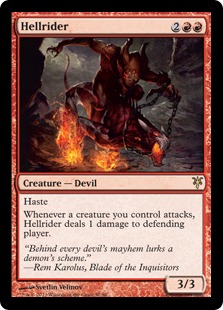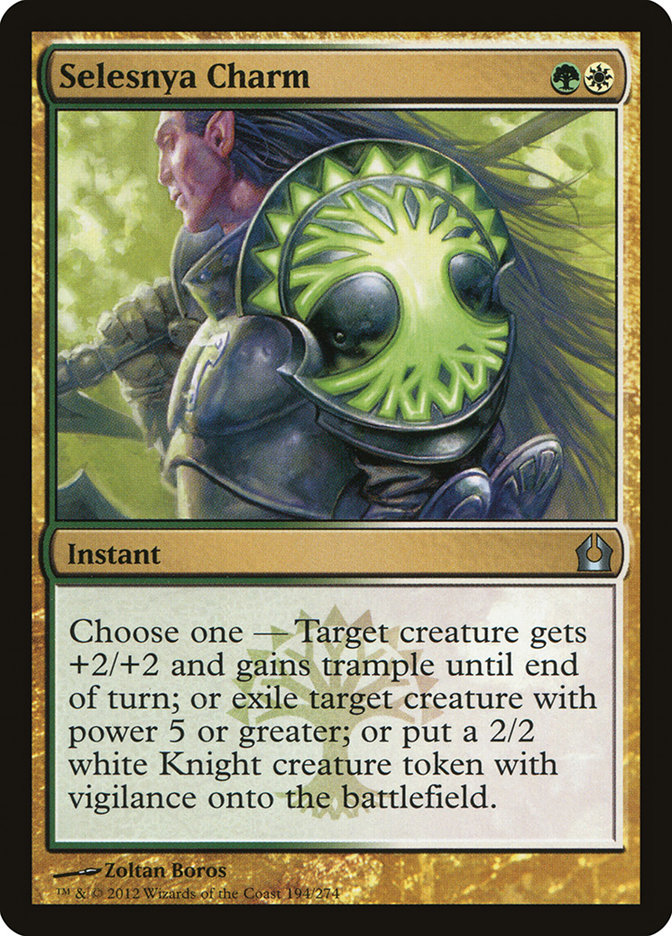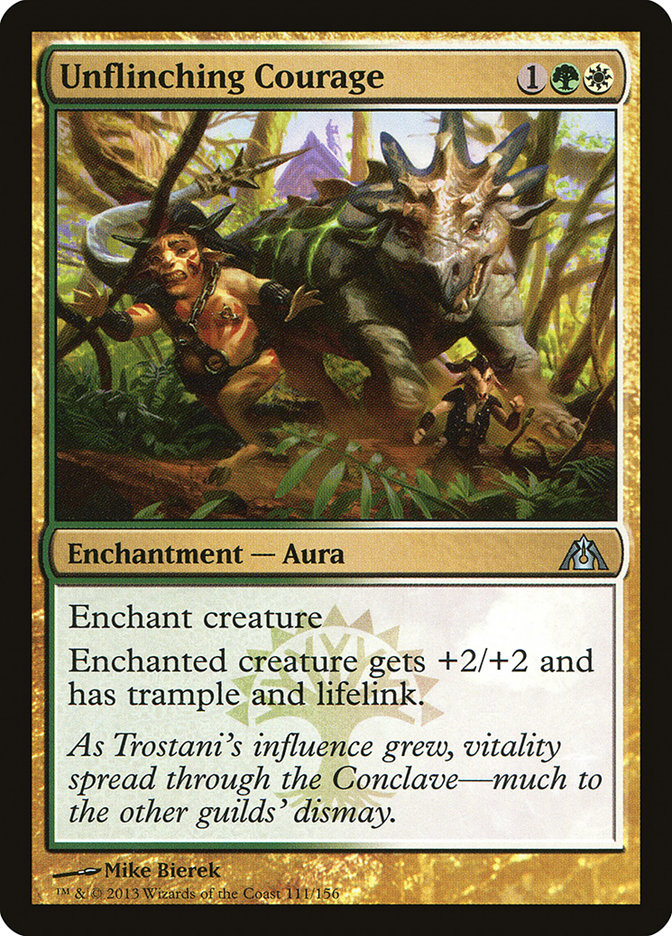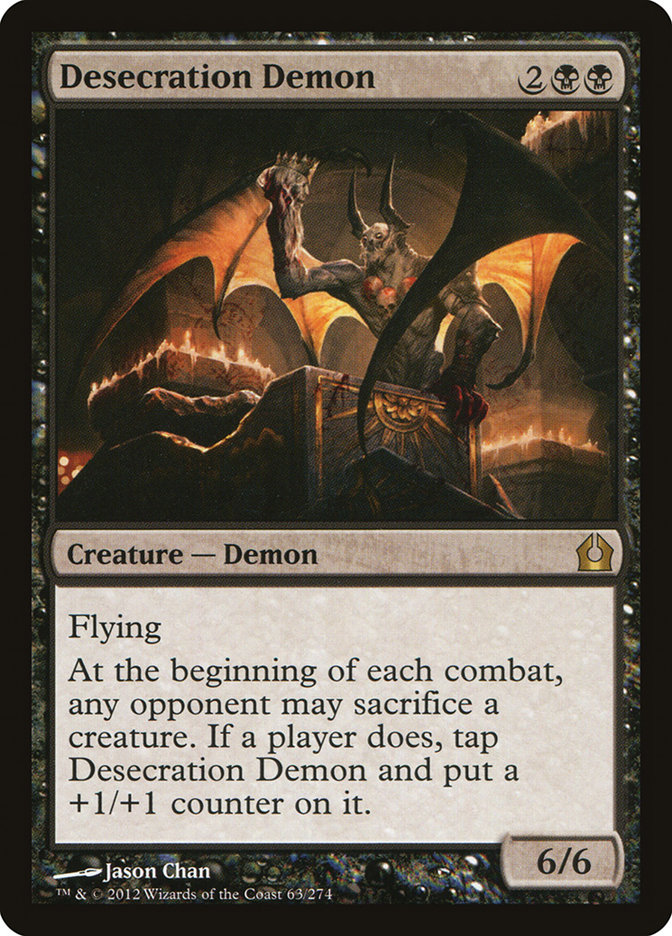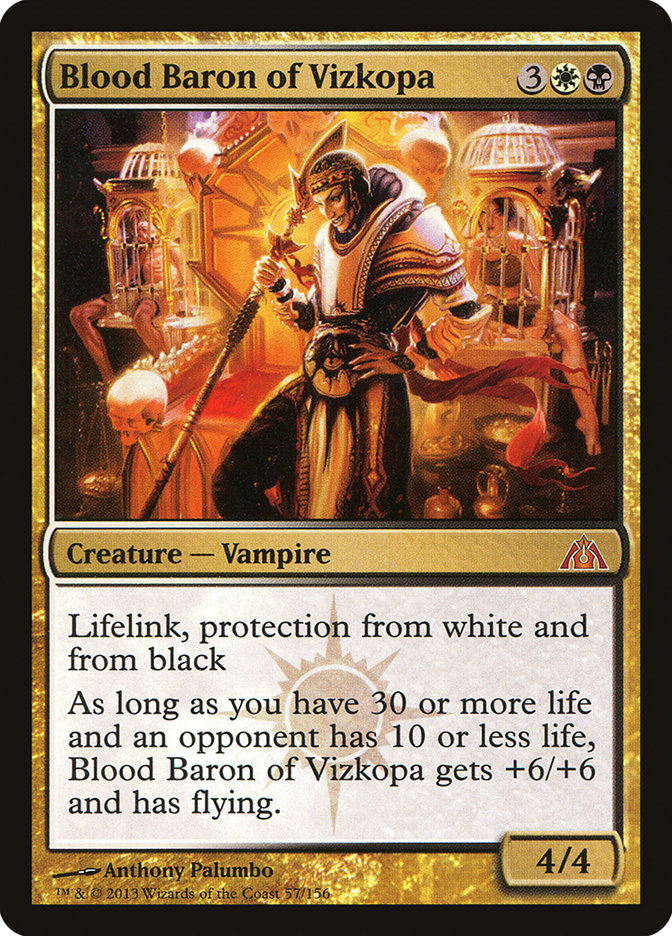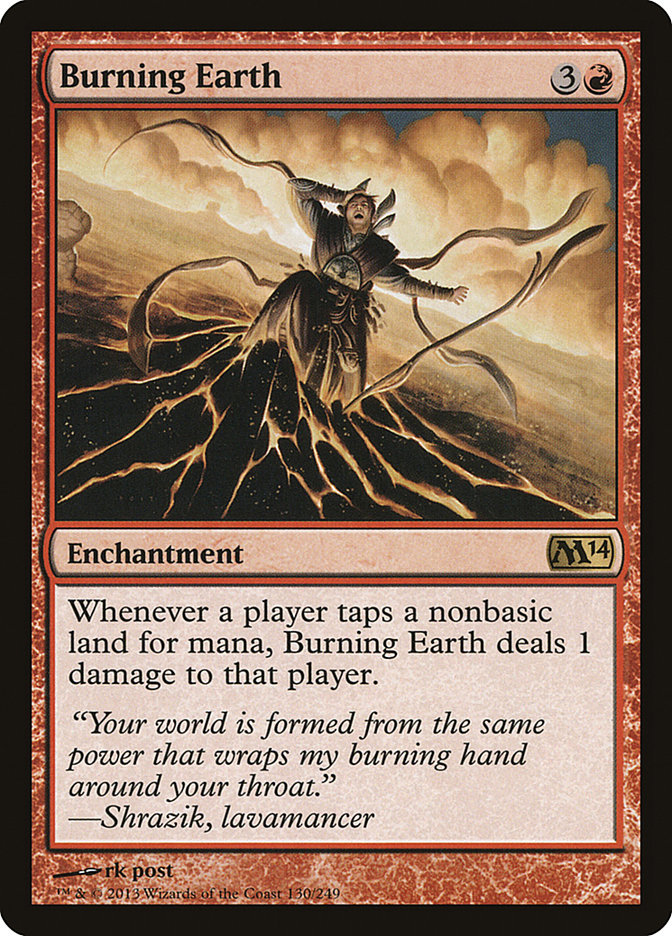If you haven’t noticed already, Standard looks a lot different than it did a few weeks ago. Where once Thragtusks and Huntmasters of the Fells reigned with only the might of Snapcaster Mage and Sphinx’s Revelation holding them in check, now there is a field of lush green and red. It’s like Christmas, really. And I’m Santa Claus.
You’re welcome.
I didn’t set out to revolutionize Standard when I built the G/R deck I played at the World Championships, nor did I realize the impact it would have. In fact, as close as two days before the tournament, I was thinking of abandoning my work on the deck and just playing Jund. It wasn’t until a late-night epiphany led me to add Hellrider and move the deck in a more aggressive direction that the list transformed into the monster that won Grand Prix Warsaw and met in a mirror match finals at the first StarCityGames.com Standard Open in Salt Lake City.
If you’re interested in the evolution of the deck on a day-by-day basis, I strongly suggest checking out the video logs I made each day in Amsterdam to chronicle my playtesting for the World Championships. Tournament reports and articles about deck choices have the advantage of hindsight, but with these video logs you can hear how I came to my decisions and the progress that happened each day—not to mention get a glimpse behind the scenes at what it’s like to test for and play in the World Championship. Check them out on my blog at bmkgaming.com.
But enough about the past. While we can all stand to learn from history, it is exactly that—history. I’m sure far more of you are interested in the question “where do we go from here?” than want to know “how did we get here?” So with that in mind, this week I’m going to talk about how to beat the monster I unleashed upon the world. I’m going to take a look at several different decks that I think may be well positioned in a G/R-heavy metagame as well as the general principles behind beating the deck.
1. Naya Midrange
The World Championship is a unique tournament. With only sixteen players, a significant percentage of the field is playing on camera during each round, which means that it’s easy to get an edge if you have access to the coverage or have friends who are watching and can tell you the contents of the other players’ decks. To remedy this problem, we were each given copies of every player’s Constructed decklist prior to the start of the format. When I saw the lists, I was thrilled. The format broke down exactly as I’d expected, with an almost even split of U/W/R Flash and Jund with myself, Craig Wescoe, and Willy Edel as the only dissenters.
As fate would have it, I was paired against Willy in the first round, and his was exactly the deck I did not want to face. Thanks to a few unfortunate draws on his side of the table and several Dragons on mine, I managed to come out with the win, but it certainly wasn’t a matchup I wanted to play.
Naya has all of the tools to beat you. They have access to the same mana acceleration, but the creatures they’re ramping into are better than yours. Where you have a bunch of two-drops to play off of your Arbor Elfs, a turn 1 Avacyn’s Pilgrim for them can mean Loxodon Smiter or Boros Reckoner, both of which outclass everything you can play short of Thundermaw Hellkite—and they have it too. You can try to punch through their superior creatures with Ghor-Clan Rampager, but Selesnya Charm is a constant threat to turn one of your Rampager-fueled attacks into an absolutely blowout.
The maindeck matchup is rough enough, but things get even worse after sideboarding. Ironically enough, the single card I was most scared of playing against with the G/R deck was the second coming of Armadillo Cloak: Unflinching Courage. If I were playing Naya today, I would sideboard a full four copies of the card because it’s virtually unbeatable for G/R. Cloaking up almost any of your creatures is incredibly hard for them to beat, and if you suit up a Boros Reckoner with Domri Rade in play? Well, I hope you double sleeved your deck because your opponent may very well vomit all over the table.
I haven’t actually played with Naya lately, but I think it has a chance to be very well positioned. I’d be scared to play against Jund with Lifebane Zombie, but I’d definitely try the same plan I used in G/R against it: Chandra, Pyromaster. Chandra can help clear out Lifebane Zombies as well as pave the way for your Loxodon Smiters to attack past Thragtusks and the like. I’m not really a financial expert by any means, but I suggest picking up Chandras while they’re still relatively cheap. I’m fairly certain she’s the real deal and that she’s going to continue to make her impact felt for the duration of her time in Standard.
Osyp Lebedowicz recently won a PTQ with Naya with four Unflinching Courages in his sideboard—I think his list is a good place to start.
Creatures (27)
- 3 Scavenging Ooze
- 4 Avacyn's Pilgrim
- 4 Thundermaw Hellkite
- 2 Flinthoof Boar
- 4 Loxodon Smiter
- 2 Ghor-Clan Rampager
- 4 Boros Reckoner
- 4 Voice of Resurgence
Planeswalkers (4)
Lands (24)
Spells (5)

2. B/x Midrange
In the waning days of my World Championship testing, I was growing so frustrated with the power level of Lifebane Zombie that I started thinking about what the best Lifebane Zombie deck would be to play in a field full of Lifebane Zombies. We tried an aggressive list but didn’t like how it matched up against the field we anticipated. I then saw the B/G deck from Grand Prix Calgary, liked the basic structure of it, and wondered whether it could be improved.
One thing that I really wanted to try was a B/W list that plays Restoration Angel to maximize the power of Lifebane Zombie. With Angel you can hit multiple cards with Zombie, and it also gives you another potentially powerful, evasive threat to go alongside Desecration Demon. Also compelling was the fact that B/W could play with Blood Baron of Vizkopa, which is dramatically better when you have Lifebane Zombie to get Thragtusk out of the way, and potentially Sin Collector to clear out any possible removal.
I can’t say for sure whether the white would be an improvement on the green, but I do know that the idea of playing against a deck with Lifebane Zombies, Desecration Demons, Mutilates, and spot removal sounds pretty tough from the G/R side of the table. Unlike against Jund, your Domri Rades and Mizzium Mortars aren’t particularly effective at killing their creatures, and they have an efficient way to clear your board with Mutilate. Add to this the fact that Burning Earth is a virtual blank and this seems like it could be trouble. Keep in mind that I haven’t actually played the matchup, but it seems like one that could be pretty difficult.
If I were looking to play B/x and I wanted to maximize my chances to beat G/R, I’d probably look in the direction of cards like Doom Blade and Victim of Night—cheap removal spells that can kill problematic haste creatures. If I were trying the B/W direction, I’d consider looking into Blind Obedience, which can seriously put a damper on the effectiveness of cards like Hellrider and Thundermaw Hellkite.
Here are a couple examples of what these decks might look like:
Creatures (16)
Planeswalkers (4)
Lands (25)
Spells (15)

Creatures (17)
Planeswalkers (3)
Lands (25)
Spells (15)

3. Bant Hexproof
I’m really not a fan of this deck because so much of the way it plays out is antithesis to what I enjoy about Magic. An Invisible Stalker basically has “protection from interaction”—if you load it up with a bunch of enchantments, it basically insists that your opponent has a very specific type of card or they lose. The deck is extremely fragile and inconsistent, yet it’s also extremely powerful. I’ve recommended the deck before despite my distaste for it, and here I am recommending it again.
As I mentioned in the section about Naya above, Unflinching Courage is perhaps the best possible card against G/R. On any hard-hitting creature, it can take the game entirely out of reach in as little as a single attack. On a creature with Rancor and two Ethereal Armors, it’s downright unbeatable. Bant Hexproof is the best Armadillo Cloak deck in Standard, and as such it’s one of the best options to play to beat G/R.
I think it takes too much for G/R to realistically hope to beat Bant Hexproof when they get a good draw with Courage, so I don’t think it’s worth sideboarding anything at all. The best small sideboard plan is probably a few Fogs since every game is going to come down to a race and Fog can buy you the turn you need to win. Even that will often not be enough, so my preference is to focus on other matchups that make up more of the field.
If people take my advice, though, Bant Hexproof is a good place to be in a field full of G/R decks. It’s not a deck I have much experience playing, so it’s hard for me to suggest a list, but you could certainly do worse than the version with which two-time Pro Tour Top 8 competitor Dennis Rachid used to make Top 8 of Grand Prix Warsaw.
Creatures (19)
- 4 Gladecover Scout
- 4 Invisible Stalker
- 4 Avacyn's Pilgrim
- 4 Geist of Saint Traft
- 1 Silverblade Paladin
- 2 Fiendslayer Paladin
Lands (22)
Spells (19)
- 4 Rancor
- 4 Spectral Flight
- 1 Increasing Savagery
- 1 Selesnya Charm
- 4 Ethereal Armor
- 1 Simic Charm
- 4 Unflinching Courage
Sideboard

Or build your own deck! Not nearly enough people do that these days. But if you want to build a deck that can go toe-to-toe with G/R, be sure to follow these important guidelines:
1) Be Proactive
Seeing as this is my number one rule for deckbuilding, this should come as no surprise, but it’s particularly important when it comes to beating G/R. Between Domri Rade and Burning Earth, the deck has a plethora of ways to punish anyone who just wants to sit back and try to eventually win the game. You need to be coming out of the gates yourself if you want to compete.
2) Go Big
Back in 2000, the most popular deck in Standard was Fires, a G/R deck based on attacking with a bunch of hasty creatures featuring a number of dangerous enchantments. Sound familiar? That tournament was my big break on the Pro Tour. I showed up with a Naya deck before Naya was something that existed, and with my Blastoderms; Jade Leeches; Rith, the Awakener; and Armadillo Cloaks (not to mention more than a few timely Armageddon), I waded my way through a field of Fires decks, including Jon Finkel and Zvi Mowshowitz, to finish in third place. Big creatures with lifelink were good against G/R decks then, and they’re good against them now. Some things never change.
3) Be Prepared for Burning Earth
For the past year, people have built their mana bases to allow them to do all kinds of outlandish things. We’ve seen Naya decks splashing Unburial Rites and Rakdos’s Return, Bant decks splashing Nephalia Drownyard, and more. Things have changed. It’s Burning Earth’s format now—the rest of us are just living in it. If you aren’t playing an incredibly proactive deck and you don’t have any basic lands, you better have the fire department on speed dial because everything around you is going up in flames.
Burning Earth is no joke, and playing a few copies of Oblivion Ring or Detention Sphere to remove it just isn’t going to cut it. Unlike many other troublesome noncreature permanents for a control deck, Burning Earth isn’t something you can ignore for a while as you try to dig for an answer. If it’s in play for multiple turns, you can’t do anything about what your opponent is doing without taking huge chunks of damage. It will kill you.
If for some godforsaken reason you insist on playing a control deck anyway, I suggest looking at the U/B deck the Czech team used at the World Magic Cup or the U/W deck that Matt Nass and Jacob Wilson played at Grand Prix Calgary. You’ll probably still lose to Domri Rade, but at least you can tap your lands without dying.
That’s it for this week. I’m spending the weekend in Indianapolis at Gen Con, so if you happen to be in the area, you should definitely stop by the Stone Blade booth and say hi. If you’re not, you should still definitely check out SolForge, which was just released into open beta this week. It’s still a bit buggy since we’re working out the kind of kinks that come along with release week of a digital game, but it’s a hell of a lot of fun already and you can play absolutely free. Check it out at solforgegame.com.
Until next time,
bmk

